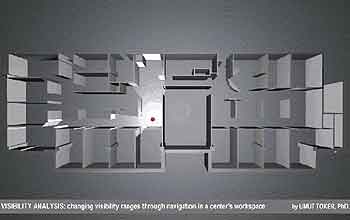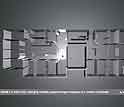News Release 04-010
Beyond Feng Shui: Designing for Innovation
Layouts that Increase the Rate of Chance Encounters Are Critical
January 30, 2004
This material is available primarily for archival purposes. Telephone numbers or other contact information may be out of date; please see current contact information at media contacts.
Arlington, VA—Anyone who hopes to create a vigorous and productive research environment should pay close attention to its physical layout, says Umut Toker—right down to the placement of the coffee pot, the refrigerator, the microwave, the group printer, the whiteboards, and all the other items that draw people together.
Clustering such attractions in the open common areas helps to increase the number of chance encounters, explains Toker, who studied the interplay of physical space and innovation at six university research centers for his recent Ph.D. dissertation in architecture at the North Carolina State University College of Design. More encounters mean more impromptu conversations about technical issues. And more conversations, in turn, mean a higher rate of innovation, whether measured by quantitative factors such as the number of published papers per unit time, or by subjective assessments such as "How innovative is the research done here?"
Another potent conversation-enhancer is increased visibility, especially in the hallways and lounges says Toker, whose work was one of several social science-based "innovation process" projects supported by the NSF Science and Technology Center for Environmentally Responsible Solvents and Processes, a multi-university initiative led by the University of North Carolina at Chapel Hill. "Spaces with clear sight lines lead to more eye contact," he says, "which means that questions pop up, and people start discussing things."
Of course, Toker adds, experienced researchers tend to know at least some of this already, if only by instinct. But researchers don't usually design their own buildings. That's why they not uncommonly find themselves working in an environment where their offices are, say, two floors away from their laboratories—a layout that Toker has found to be far less effective for innovation than having the labs and offices intermingled. "There is no single formula for all centers," he says. But even so, if designers can plan new research centers with a good understanding of how its spatial layout affects the person-to-person flow of information, they can do a lot to help that center meet its goals.
-NSF-
-
View Video
A video clip illustrating an analytical tool that Toker developed.
Credit and Larger Version
Media Contacts
M. Mitchell Waldrop, NSF, (703) 292-7752, email: mwaldrop@nsf.gov
Principal Investigators
Umut Toker, North Carolina State University College of Design, (919) 828-3925, email: uztoker@bellsouth.net
The U.S. National Science Foundation propels the nation forward by advancing fundamental research in all fields of science and engineering. NSF supports research and people by providing facilities, instruments and funding to support their ingenuity and sustain the U.S. as a global leader in research and innovation. With a fiscal year 2023 budget of $9.5 billion, NSF funds reach all 50 states through grants to nearly 2,000 colleges, universities and institutions. Each year, NSF receives more than 40,000 competitive proposals and makes about 11,000 new awards. Those awards include support for cooperative research with industry, Arctic and Antarctic research and operations, and U.S. participation in international scientific efforts.
Connect with us online
NSF website: nsf.gov
NSF News: nsf.gov/news
For News Media: nsf.gov/news/newsroom
Statistics: nsf.gov/statistics/
Awards database: nsf.gov/awardsearch/
Follow us on social
Twitter: twitter.com/NSF
Facebook: facebook.com/US.NSF
Instagram: instagram.com/nsfgov




